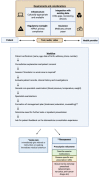Telemedicine as the New Outpatient Clinic Gone Digital: Position Paper From the Pandemic Health System REsilience PROGRAM (REPROGRAM) International Consortium (Part 2)
- PMID: 33014958
- PMCID: PMC7505101
- DOI: 10.3389/fpubh.2020.00410
Telemedicine as the New Outpatient Clinic Gone Digital: Position Paper From the Pandemic Health System REsilience PROGRAM (REPROGRAM) International Consortium (Part 2)
Abstract
Technology has acted as a great enabler of patient continuity through remote consultation, ongoing monitoring, and patient education using telephone and videoconferencing in the coronavirus disease 2019 (COVID-19) era. The devastating impact of COVID-19 is bound to prevail beyond its current reign. The vulnerable sections of our community, including the elderly, those from lower socioeconomic backgrounds, those with multiple comorbidities, and immunocompromised patients, endure a relatively higher burden of a pandemic such as COVID-19. The rapid adoption of different technologies across countries, driven by the need to provide continued medical care in the era of social distancing, has catalyzed the penetration of telemedicine. Limiting the exposure of patients, healthcare workers, and systems is critical in controlling the viral spread. Telemedicine offers an opportunity to improve health systems delivery, access, and efficiency. This article critically examines the current telemedicine landscape and challenges in its adoption, toward remote/tele-delivery of care, across various medical specialties. The current consortium provides a roadmap and/or framework, along with recommendations, for telemedicine uptake and implementation in clinical practice during and beyond COVID-19.
Keywords: COVID-19; coronavirus disease 2019; telemedicine; teleneurology; telepsychiatry; telerehabilitation.
Copyright © 2020 Bhaskar, Bradley, Chattu, Adisesh, Nurtazina, Kyrykbayeva, Sakhamuri, Moguilner, Pandya, Schroeder, Banach and Ray.
Figures

Similar articles
-
Telemedicine Implementation on a Bariatric Outpatient Clinic During COVID-19 Pandemic in Italy: an Unexpected Hill-Start.Obes Surg. 2020 Dec;30(12):5145-5149. doi: 10.1007/s11695-020-05007-z. Epub 2020 Sep 27. Obes Surg. 2020. PMID: 32981003 Free PMC article.
-
Telemedicine Across the Globe-Position Paper From the COVID-19 Pandemic Health System Resilience PROGRAM (REPROGRAM) International Consortium (Part 1).Front Public Health. 2020 Oct 16;8:556720. doi: 10.3389/fpubh.2020.556720. eCollection 2020. Front Public Health. 2020. PMID: 33178656 Free PMC article.
-
Telemedicine During COVID-19 and Beyond: A Practical Guide and Best Practices Multidisciplinary Approach for the Orthopedic and Neurologic Pain Physical Examination.Pain Physician. 2020 Aug;23(4S):S205-S238. Pain Physician. 2020. PMID: 32942812
-
Telemedicine and the Interdisciplinary Clinic Model: During the COVID-19 Pandemic and Beyond.Otolaryngol Head Neck Surg. 2020 Oct;163(4):673-675. doi: 10.1177/0194599820932167. Epub 2020 Jun 2. Otolaryngol Head Neck Surg. 2020. PMID: 32484731 Review.
-
Telemedicine and current clinical practice trends in the COVID-19 pandemic.Best Pract Res Clin Anaesthesiol. 2021 Oct;35(3):307-319. doi: 10.1016/j.bpa.2020.11.005. Epub 2020 Nov 16. Best Pract Res Clin Anaesthesiol. 2021. PMID: 34511221 Free PMC article. Review.
Cited by
-
Virtual Reality as a Technological-Aided Solution to Support Communication in Persons With Neurodegenerative Diseases and Acquired Brain Injury During COVID-19 Pandemic.Front Public Health. 2021 Feb 16;8:635426. doi: 10.3389/fpubh.2020.635426. eCollection 2020. Front Public Health. 2021. PMID: 33665181 Free PMC article.
-
Digital exclusion and functional dependence in older people: Findings from five longitudinal cohort studies.EClinicalMedicine. 2022 Oct 31;54:101708. doi: 10.1016/j.eclinm.2022.101708. eCollection 2022 Dec. EClinicalMedicine. 2022. PMID: 36353265 Free PMC article.
-
Patient Readiness for Remote Healthcare Services in the Context of the COVID-19 Pandemic: Evidence From European Countries.Front Public Health. 2022 Mar 15;10:846641. doi: 10.3389/fpubh.2022.846641. eCollection 2022. Front Public Health. 2022. PMID: 35372199 Free PMC article.
-
Dermatologists' Perceptions of the Use of Teledermatology in Managing Hidradenitis Suppurativa: Survey Study.JMIR Dermatol. 2023 Jan 31;6:e43910. doi: 10.2196/43910. JMIR Dermatol. 2023. PMID: 37632921 Free PMC article.
-
The impact of the SARS-CoV-2 pandemic on the management of chronic limb-threatening ischemia and wound care.Wound Repair Regen. 2022 Jan;30(1):7-23. doi: 10.1111/wrr.12975. Epub 2021 Oct 29. Wound Repair Regen. 2022. PMID: 34713947 Free PMC article. Review.
References
-
- Bhaskar S, Rastogi A, Chattu VK, Adisesh A, Thomas P, Alvarado N, et al. . Key Strategies for clinical management and improvement of healthcare services for cardiovascular disease and diabetes patients in the coronavirus (COVID-19) settings: recommendations from the REPROGRAM consortium. Front Cardiovasc Med. (2020) 7:112. 10.3389/fcvm.2020.00112 - DOI - PMC - PubMed
-
- American Telemedicine Association About Telemedicine. Available online at: http://legacy.americantelemed.org/main/about/about-telemedicine/telemedi... (accessed April 16, 2020).
MeSH terms
LinkOut - more resources
Full Text Sources
Medical

